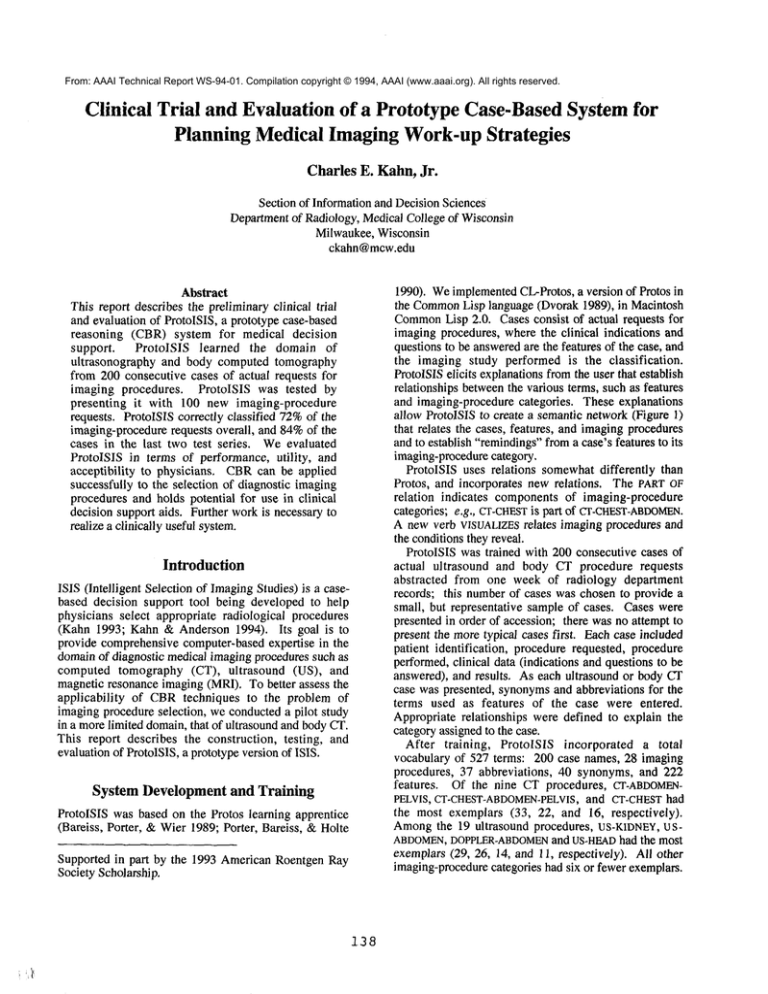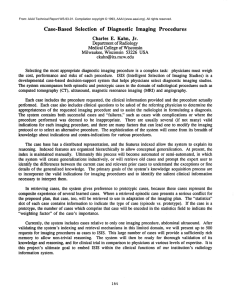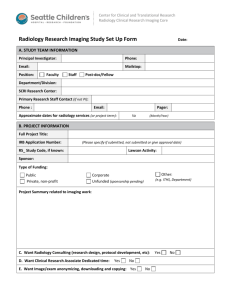
From: AAAI Technical Report WS-94-01. Compilation copyright © 1994, AAAI (www.aaai.org). All rights reserved.
Clinical Trial and Evaluation of a Prototype Case-BasedSystem for
Planning Medical Imaging Work-upStrategies
Charles E. Kahn,Jr.
Section of Information and Decision Sciences
Department of Radiology, Medical College of Wisconsin
Milwaukee, Wisconsin
ckahn@mcw.edu
Abstract
This report describes the preliminary clinical trial
and evaluation of ProtolSIS, a prototype case-based
reasoning (CBR) system for medical decision
support.
ProtolSIS
learned the domain of
ultrasonography and body computed tomography
from 200 consecutive cases of actual requests for
imaging procedures. ProtolSIS was tested by
presenting it with 100 new imaging-procedure
requests. ProtolSIS correctly classified 72%of the
imaging-procedure requests overall, and 84%of the
cases in the last two test series. Weevaluated
ProtolSIS in terms of performance, utility, and
acceptibility to physicians. CBRcan be applied
successfully to the selection of diagnostic imaging
procedures and holds potential for use in clinical
decision support aids. Further work is necessary to
realize a clinically useful system.
Introduction
ISIS (Intelligent Selection of ImagingStudies) is a casebased decision support tool being developed to help
physicians select appropriate radiological procedures
(Kahn 1993; Kahn & Anderson 1994). Its goal is
provide comprehensive computer-based expertise in the
domainof diagnostic medical imaging procedures such as
computed tomography (CT), ultrasound (US),
magnetic resonance imaging (MRI). To better assess the
applicability
of CBRtechniques to the problem of
imaging procedure selection, we conducted a pilot study
in a more limited domain,that of ultrasound and body CT.
This report describes the construction, testing, and
evaluation of ProtolSIS, a prototype version of ISIS.
System Development and Training
ProtolSIS was based on the Protos learning apprentice
(Bareiss, Porter, &Wier 1989; Porter, Bareiss, &Holte
Supported in part by the 1993 American Roentgen Ray
Society Scholarship.
138
1990). WeimplementedCL-Protos, a version of Protos in
the Common
Lisp language (Dvorak 1989), in Macintosh
Common
Lisp 2.0. Cases consist of actual requests for
imaging procedures, where the clinical indications and
questions to be answeredare the features of the case, and
the imaging study performed is the classification.
ProtolSIS elicits explanations from the user that establish
relationships betweenthe various terms, such as features
and imaging-procedure categories. These explanations
allow ProtolSIS to create a semantic network (Figure 1)
that relates the cases, features, and imaging procedures
and to establish "remindings"froma case’s features to its
imaging-procedure category.
ProtolSIS uses relations somewhatdifferently than
Protos, and incorporates new relations. The PARTOF
relation indicates components of imaging-procedure
categories; e.g., CT-CHEST
is part of CT-CHEST-ABDOMEN.
A new verb VISUALIZESrelates imaging procedures and
the conditions they reveal.
ProtolSIS was trained with 200 consecutive cases of
actual ultrasound and body CT procedure requests
abstracted from one week of radiology department
records; this numberof cases was chosen to provide a
small, but representative sample of cases. Cases were
presented in order of accession; there was no attempt to
present the more typical cases first. Each case included
patient identification, procedure requested, procedure
performed, clinical data (indications and questions to be
answered), and results. As each ultrasound or body CT
case was presented, synonymsand abbreviations for the
terms used as features of the case were entered.
Appropriate relationships were defined to explain the
category assigned to the case.
After training,
ProtoISIS incorporated a total
vocabulary of 527 terms: 200 case names, 28 imaging
procedures, 37 abbreviations, 40 synonyms, and 222
features. Of the nine CT procedures, CT-ABDOMENPELVIS, CT-CHEST-ABDOMEN-PELVIS,
and CT-CHESThad
the most exemplars (33, 22, and 16, respectively).
Amongthe 19 ultrasound procedures, US-KIDNEY,
USABDOMEN,
DOPPLER-ABDOMEN
and US-HEAD
had the most
exemplars (29, 26, 14, and 11, respectively). All other
imaging-procedurecategories had six or fewer exemplars.
Each exemplar consisted of one or more features: 66
exemplars (33%) had only one feature, another 77 (38%)
had two features, and none had more than seven features.
All but 13 (5.9%) of the 222 features had remindings
one or more imaging procedures. The great majority of
features (76.4%) had remindings to only one imaging
procedure; none had remindings to more than three
imaging procedures.
as abbreviations, synonyms, and features - that were
encountered in the test cases whether or not the case to
which they belonged was itself added.
Because the underlying CBRsystem, Protos, is an
incremental knowledge acquisition
system, it is
susceptible to order effects in the training it receives. The
current study was designed to assess overall feasibility,
and did not account for this phenomenon:training cases
were presented in the same order in which they were
received, rather than presenting the most exemplarycases
first. Future evaluations will control for order effects by
not including the test cases in the system’s memoryand
by presenting the training cases in several randomized
orders to determine average performance.
ProtolSIS demonstratedsatisfactory performancein the
four test series. Onlythree of the 100 test cases required
new imaging-procedure
categories:
CT-ABDOMENDRAINAGE, CT-LIVER-BIOPSY,
and US-AORTA. Overall,
ProtolSIS correctly classified 72%of the imagingprocedure requests on the first attempt. Its performance
improved as it gained experience: in the last two test
series, it correctly classified 84%of the cases presented,
comparedwith only 56%in the first series. In manyof
the incorrectly classified cases, the correct imaging
procedure received the second highest matching score.
Clinical Trial
We presented ProtolSIS with 100 new, consecutive
ultrasound and body CTcases from radiology department
records. The cases were grouped into four sets of 25
cases each, presented sequentially; we divided the test
cases into groups to assess the improvementin ProtolSIS’
performance as it gained experience. After each case’s
identifier and clinical features were entered, the system
attempted to assign the correct category to each case. If
ProtolSIS was unable to assign a category or assigned an
incorrect category to a case, we added that case and
pertinent
explanations
into memory. ProtolSIS
incorporated into its knowledgebase all newterms - such
Figure 1. Semanticnetworkof terms and relations in ProtolSIS.
139
On average, 40%of cases included terms that had not
been encountered previously; given the small numberof
training cases, the large vocabulary of medicine, and the
variety of ways that a single medical concept can be
expressed,this finding is not surprising.
Evaluation
Performance
ProtoISIS performed reasonably well based on its small
set of training cases, but not at a level suitable for clinical
use. In order to be accepted into clinical practice, a
decision support system must perform as well or better
than physicians, and importantly, the physicians against
whomone tests the system must be specialists or subspecialists in the given domain. A very encouraging
aspect of developing ProtoISIS was the relative ease of
acquiring and entering the system’s knowledgebase.
More cases are needed to provide a suitable level of
sophistication. Although one week of imaging requests
-- as used in ProtoISIS -- provides a representative
sample of cases, it does not provide sufficient depth of
knowledgefor ISIS to function at the level of an expert
clinician. In addition, ISIS needs more information about
each case, and more structure in that information. ISIS
must distinguish betweenknownfeatures (patient history)
and those being queried (clinical questions). In ProtoISIS,
for example, the feature GALLSTONES
might indicate
either knowngallstones or a question of gallstones.
In addition to the procedurerequested and the clinical
information provided, each case will include information
about the procedure actually performed and the imaging
technique or protocol. Each case will include clinical
questions to be asked of the referring physician to
determine the appropriateness of the requested imaging
procedure and to assist the radiologist in formulating a
diagnosis. ISIS’ memorywill incorporate "failures," such
as non-diagnostic studies, inappropriately chosenstudies,
and cases with complications.
Interaction
with Physicians
Although CL-Protos provides very efficient and easily
understandableinterfaces, they are not be suitable for use
by physicians. Wewill need to develop user interfaces
that limit the functionality of the system: several of the
features available in CL-Protos are best used by
programmers and "knowledge engineers." In addition,
information being entered or presented must be clustered
in ways that corresponds to typical clinical scenaria. We
plan to "embed" ISIS into our radiology department’s
clinical information system; such integration offers the
greatest potential impact on clinical care (Rossi-Mori,
Pisanelli, & Ricci 1990). Most commercial radiology
information systems are based on VT100-type24-line, 80column displays. Integration with these system will
require special attention to the user interfaces to assure
ease of use.
The ability of a medical decision support system to
explain its reasoning is crucial to its acceptance by
physicians. For each case, the expert user can provide
commentsor explanations which will be retrieved when
viewing the case. Weanticipate that these plain-text
comments will correspond to the indexing features
identified for the case. Future work will examine the
ability to generate the explanations automatically from the
case information. In addition, the commentsfor a case
mayinclude references to pertinent medicalliterature.
Some of the explanations generated by the Protos
knowledge-based pattern matching algorithm did not
represent valid reasoning. The most typical error was to
present a chain of explanatory links that were too heavily
dependent on the first exemplars seen by the system. In
several instances, even though new explanations were
offered, ProtolSIS continued to base its explanations on
the earliest exemplars seen in each imaging-procedure
category. Someof the errors may have been caused by
incorrect use of Protos’ relation verbs in several cases.
Developers of medical decision support systems have
abandoned the "Greek oracle" model that assumed that
physicians wouldconveyall necessary data to the expert
system and await its decision (Miller 1990; Miller
Masarie 1990). The "critiquing" approach allows
physician to propose a solution; the decision support
system then responds to the physician’s proposal and
identifies the evidencesupporting it or against it (Miller
1983). The physician and decision support system can
engage in a dialogue to refine the proposed plan. This
approach allows more robust interaction between the
physician and the decision support system. This approach
was been applied to radiology procedure selection in a
rule-based system(Swett et al. 1989).
ISIS must integrate case-based reasoning with a
critiquing approach. The critiquing approach allows ISIS
to propose a revised or alternative plan and allows the
physician to override its suggestions. In a consultative
specialty such as diagnostic radiology, this modeof
interaction and knowledgesharing is essential to the
relationship between the radiologist (who knows the
imaging procedures) and the referring physician (who
knowsthe patient). This modeof interaction resembles
retrieve-and-propose systems such as REPRO
(Simoudis
&Miller 1993).
Open Issues
Noise. In the current domain, the problem of "noise" can
manifest itself as twoor morecases with identical clinical
information but different proposed plans (i.e., selected
imaging procedures). Physicians may choose different
plans based on identical clinical information due to
overlap of the diagnostic abilities
of the imaging
procedures or difference of opinion among expert
physicians.
To account for such "noise" within the system’s
memory, the system might count the number of
occurrences of each alternative plan; the one used most
frequently thus becomesthe "preferred" plan, with other,
less commonplans allowed on the basis of precedent.
This approach permits diversity of opinion, yet can help
discourage physicians from selecting suboptimal
procedures. If the secondary approach comesto be chosen
with increasing frequency, then its weighting factor will
exceed the other’s and it will be considered the "primary"
modality for the given problem. This approach will
provide the system with flexibility
to accommodate
changes in protocols and procedures due to evolving
medical imaging technology.
Episodic and Prototypie Cases. ProtolSIS included
only "episodic" cases: all were derived from actual
clinical records. It is not yet clear whetheror not we will
need to incorporate prototypical cases to represent
medical practice guidelines. In retrieving cases, ISIS
might need to give precedence to prototypic cases,
because these cases presumably represent the composite
experience of several learned cases. Wherea retrieved
episodic case presents a serious conflict for the proposed
plan, that case, too, would be retrieved to use in
adaptation of the imagingplan.
Case Weighting. Another open question is the use of
weights to indicate whichcases merit greater attention as
exemplars. Such information might be placed in a
"statistics" slot of each case. If the case is a prototype,the
numberof actual cases that comprise the prototypic case
could be encodedin the statistics field to indicate the
"weightingfactor" of the case’s importance.
procedure selection include rule-based systems (Swett et
al. 1989; Kahn 1991b), hypertexts (Greenes et al. 1989;
Kahn 1991a), and belief networks (Haddawy, Kahn,
Butarbutar 1994). Once ISIS has been completed and
validated, it will integrated with our department’sclinical
information system to provide interactive,
on-line
expertise to physicians at all times of the day in work
areas such as clinics, inpatient wards, intensive-care units
and the emergencydepartment. Such a system will have
excellent potential to significantly improvethe quality and
cost-effectiveness of medical care, and will offer an
opportunity to study the role of case-based reasoning in
day-to-day medical decision making.
Acknowledgments
CL-Protos, written by Daniel L. Dvorak, is based on the
Protos system originally developed by Ray Bareiss and
BruceW.Porter at the University of Texasat Austin.
References
Bareiss, E. R.; Porter, B. W.; and Wier, C, C. 1989.
PROTOS:an exemplar-based learning apprentice.
International Journal of Man-MachineStudies 29:549561.
Bareiss, R. 1989. The experimental evaluation of a casebased learning apprentice. In: Hammond,K., ed. CaseBased Reasoning: Proceedings of a Workshopon CaseBased Reasoning, 162-167. San Mateo, CA: Morgan
KaufmannPublishers, Inc.
Berger, J. 1992. ROENTGEN:
case-based reasoning and
radiation therapy planning. Proceedings of the 16th
Annual Symposiumon ComputerApplications in Medical
Care, 210-214. NewYork: McGraw-Hill.
Berger, J. 1993. Knowledge acquisition and design
support in a medical domain. In: Leake, D. B., ed. CaseBased Reasoning: Papers from the 1993 Workshop
(Technical Report WS-93-01), 141-146. MenloPark, CA:
AAAIPress.
Dvorak, D. 1989. CL-Protos User’s Guide. Austin, TX:
Artificial
Intelligence Laboratory, Department of
ComputerSciences, The University of Texas at Austin.
Greenes, R. A., et al. 1989. Knowledgemanagementas a
decision support method: a diagnostic workup strategy
application. Computersand Biomedical Research 22:113135.
Haddawy,P.; Kahn, C. E., Jr; and Butarbutar, M. 1994. A
Bayesian network model for radiological diagnosis and
procedure selection: work-up of suspected gallbladder
disease. MedicalPhysics (in press).
Kahn, C. E., Jr. 1991a. A radiology hypertext system for
education and clinical decision making.Journal of Digital
Imaging 4:207-212.
FutureDirections
Case-based reasoning has been applied experimentally in
medicine to clinical audiology (Bareiss, Porter, & Wier
1989; Bareiss 1989; Porter, Bareiss, & Holte 1990),
diagnosis of heart failure (Koton 1989b; Koton 1989a),
and planning of radiation therapy protocols (Berger 1992;
Berger 1993). Although these systems have been
validated, to this author’s knowledge, they are not in
routine clinical use.
Once completed, ISIS will be integrated with the
radiology information system of United Regional Medical
Services, which provides radiology services to two large
teaching hospitals on the grounds of the Milwaukee
Regional Medical Center. Our radiology department
performs more than 200,000 procedures annually,
including about 36,000 imaging procedures. The clinical
implementation of ISIS will permit investigation of a
CBRdecision aid in day-to-day clinical practice. This
setting will provide an excellent "production system"test
of ISIS, and will serve as a pilot project for "scaling up"
the systemto include all radiology procedures.
Conclusion
Existing decision support systems for radiological
141
Kahn, C. E., Jr. 1991b. Validation, clinical trial, and
evaluation of a radiology expert system. Methods of
Information in Medicine 30:268-274.
Kahn,C. E., Jr. 1993. Case-basedselection of diagnostic
imaging procedures. In: Leake, D. B., ed. Case-Based
Reasoning: Papers from the 1993 Workshop, 164. Menlo
Park, CA: AAAIPress.
Kahn, C. E., Jr, and Anderson, G. M. 1994. Case-based
reasoning and imagingprocedure selection: a pilot study.
Investigative Radiology(in press).
Koton, P. 1989a. Evaluating case-based problem solving.
In: Hammond, K., ed. Case-Based Reasoning:
Proceedings of a Workshop on Case-Based Reasoning,
173-175. San Mateo, CA: Morgan KaufmannPublishers,
Inc.
Koton, P. 1989b. A medical reasoning program that
improves with experience.
Computer Methods and
Programsin Biomedicine 30:177-184.
Miller, P. L. 1983. Critiquing anesthetic management:the
"ATTENDING"computer system. Anesthesiology
58:362-369.
Miller, R. A. 1990. Whythe standard view is standard:
people, not machines, understand patients’ problems.
Journal of Medicine and Philosophy 15:581-591.
Miller, R. A., and Masarie, F. E., Jr. 1990. The demiseof
the "Greek Oracle" modelfor medical diagnosis systems.
Methodsof lnformation in Medicine 29:1-2.
Porter, B. W.; Bareiss, R.; and Holte, R. C. 1990. Concept
learning and heuristic classification
in weak-theory
domains.Artificial Intelligence 45:229-263.
Rossi-Mori, A.; Pisanelli, D. M.; and Ricci, F. L. 1990.
Evaluation stages and design steps for knowledge-based
systems in medicine. Medical Informatics 15:191-204.
Simoudis, E., and Miller, P. 1993. Automatedsupport of
developing retrieve-and-propose systems. In: Leake, D.
B., ed. Case-Based Reasoning: Papers from the 1993
Workshop(Technical Report WS-93-01), 147-152. Menlo
Park, CA: AAAIPress.
Swett, H. A., et al. 1989. Optimizing radiologic workup:
an artificial intelligence approach. Journal of Digital
Imaging 2:15-20.
142








